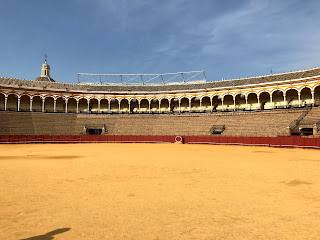On Saturday, November 17th, we walked about 10 minutes to “the Cathedral of Bullfighting”, the 12,000 seat bullfighting arena of Sevilla. When we arrived, we had to wait about 15 minutes for the next 45 minute group tour, which is the only way to get in at this time of year. Bullfighting season is from Easter Sunday until sometime in October. Construction on this bullring started in 1758 and took something like 120 years to complete. Since it is privately owned, there were periods when the owners ran out of funds and had to stop for awhile.
Along with the bullring in Ronda, here in this bullring was the start of bullfighting as a sport. Originally, bullfighting was done on horseback as military training in horsemanship. The logic was that the Mediterranean bull was the strongest, fiercest opponent that a mounted soldier could face so training against one would really hone skills. Eventually, bullfighting on foot evolved into the sport that many people in Spain still love, despite the obvious issues with political correctness.
First we were taken to a small art gallery filled with paintings of bullfighting scenes and matadors, who are revered celebrities here. The next room was a museum of artefacts from the many years of bullfighting here, including capes, matadors’ suits, lances, sculptures, photos, old posters and lots of famous bulls’ heads mounted on the walls.
From there we walked in the arched corridors under the stands to the door where the horses and bullfighters entered. There is a small chapel where the bullfighters pray before the fight, although a matador has not been killed in a bullfight in Spain since 1947. The bulls haven’t been so lucky.
Finally we entered the bullring. It was quite a feeling to be in the centre of the ring, looking up at the stands where 12,000 fans, and perhaps the king in the royal box, still cheer on the matadors. For a matador, fighting here is the pinnacle of the sport.
For the rest of the day we wandered up Constitution Avenue, the main pedestrian thoroughfare, and down to the Alfonso XIII hotel, a very elaborate building from 1929. Near it is the Fabrica de Tabacos (tobacco factory) that was once the building with the second largest footprint in Spain and was part of the setting for the opera Carmen. It is now part of the university. There are beautiful buildings throughout the old part of Sevilla thanks to the riches brought back from the New World. Sevilla may very well live up to its reputation as the most beautiful city in the world.
Late in the afternoon we ate tapas at the Bodega Santa Cruz and bought breakfast items at our favourite bakery. An evening stroll is a local pastime in Sevilla.
We had been told that a local bar, La Carboneria, about 10 minutes walk from our hotel, was a good place to see local flamenco music. We arrived there about 7:15 for a drink but the music wouldn’t start until after 9 pm. Unfortunately, we couldn’t last that long.
Along with the bullring in Ronda, here in this bullring was the start of bullfighting as a sport. Originally, bullfighting was done on horseback as military training in horsemanship. The logic was that the Mediterranean bull was the strongest, fiercest opponent that a mounted soldier could face so training against one would really hone skills. Eventually, bullfighting on foot evolved into the sport that many people in Spain still love, despite the obvious issues with political correctness.
First we were taken to a small art gallery filled with paintings of bullfighting scenes and matadors, who are revered celebrities here. The next room was a museum of artefacts from the many years of bullfighting here, including capes, matadors’ suits, lances, sculptures, photos, old posters and lots of famous bulls’ heads mounted on the walls.
From there we walked in the arched corridors under the stands to the door where the horses and bullfighters entered. There is a small chapel where the bullfighters pray before the fight, although a matador has not been killed in a bullfight in Spain since 1947. The bulls haven’t been so lucky.
Finally we entered the bullring. It was quite a feeling to be in the centre of the ring, looking up at the stands where 12,000 fans, and perhaps the king in the royal box, still cheer on the matadors. For a matador, fighting here is the pinnacle of the sport.
For the rest of the day we wandered up Constitution Avenue, the main pedestrian thoroughfare, and down to the Alfonso XIII hotel, a very elaborate building from 1929. Near it is the Fabrica de Tabacos (tobacco factory) that was once the building with the second largest footprint in Spain and was part of the setting for the opera Carmen. It is now part of the university. There are beautiful buildings throughout the old part of Sevilla thanks to the riches brought back from the New World. Sevilla may very well live up to its reputation as the most beautiful city in the world.
Late in the afternoon we ate tapas at the Bodega Santa Cruz and bought breakfast items at our favourite bakery. An evening stroll is a local pastime in Sevilla.
We had been told that a local bar, La Carboneria, about 10 minutes walk from our hotel, was a good place to see local flamenco music. We arrived there about 7:15 for a drink but the music wouldn’t start until after 9 pm. Unfortunately, we couldn’t last that long.









No comments:
Post a Comment